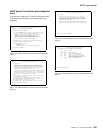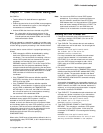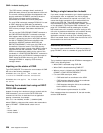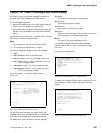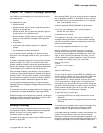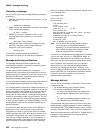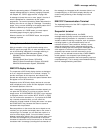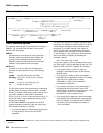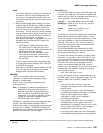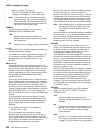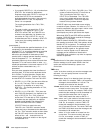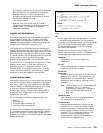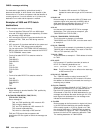
CMSG—message switching
When the processing status is TRANSACTION, you must
request message delivery by entering a paging command,
see Chapter 22, “CSPG—page retrieval” on page 253.
A message is formed into one or more “pages”, the size of
which is predefined for a destination by the system
programmer. The terminal processing status determines the
delivery of the first or only page of a message. Succeeding
pages, if any, are sent according to the paging status of the
terminal as defined by the system programmer.
When the terminal is in PAGE status, you must request
succeeding pages through a paging command.
When the terminal is in AUTOPAGE status, the complete
message is printed.
Subsystems and terminal systems
With the exception of any specific details relating to the
ROUTE option (see page 237), all other information on the
use of the following subsystems in message switching is
given in the appropriate IBM subsystem guides:
IBM 3600 Finance Communication System (VTAM),
SC33-0233
IBM 3650 Retail Store System, SC33-0234
IBM 3770 Data Communication System, SC33-0235
IBM 3790 Communication System, SC33-0236.
IBM 3270 display devices
The responses to 3270 family display devices are designed
to fit on a single 40-character line of a Model 1 display. To
provide more space for the response, the indicators that
precede the response do not have the spaces between them
that appear on non-3270 terminals.
Responses to the 3270 family display devices do not erase
what is displayed on the screen and are displayed in the last
40 character positions of the line.
After a message-switching transaction has been started, you
can press the CLEAR key if you want to continue from an
empty screen. A CLEAR/CANCEL OR CONT xxxxx response
is displayed, where xxxxx is either INPUT, ROUTE, or MSG.
You can continue the transaction or, if you press the CLEAR
key a second consecutive time, you can cancel the
transaction. A better method of erasing the screen is to press
the ERASE INPUT key, because this does not cause an
interaction with the processor.
Because positions on the screen that are not keyed are not
received, you can position and display data on the screen in
various ways. For example, you can start each option on a
new line of the display screen. You must include a comma
between consecutive options. Also, if you want to start a new
line within the message text you should enter a field mark
character to indicate the end of the current line. All field mark
characters within a message (including the first character of
the message) are interpreted as NL characters (there is no
corresponding key on 3270 family display devices) and
cause correct positioning of the message on all other
terminals.
IBM 3767 Communication Terminal
The keyboard/printer unit of the 3767 is eligible for entering
and receiving messages.
Sequential terminal
On a sequential (BSAM) terminal, the CMSG
message-switching facility remains conversational until a
message-switching transaction is completed or canceled.
Variable conditions requiring a response, such as operators
not being signed on, can be handled easily from an
interactive terminal. These conditions, however, cannot
always be anticipated, and the message-switching task
continues reading input and issuing error messages until a
valid response is received. It is possible that an entire
sequential input stream could be consumed in such a
process. You are advised to ensure that a CMSG CANCEL
record appears in the sequential input following each
message-switching transaction that could possibly require an
unanticipated reply. This is strongly recommended following
the final message-switching transaction.
Chapter 19. Message switching CMSG 233



